Dec 12, 2018
4 Steps for Students to Bring DIY Solar to Your School
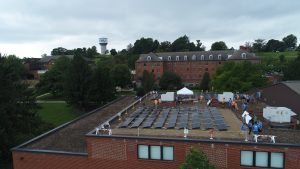
Students at colleges and universities around Virginia and across the country have been asking their schools to go solar. But when administrators at one college weren’t ready to commit to a solar project, students took matters into their own hands.
Students at Eastern Mennonite University in Harrisonburg pride themselves on their sustainability initiatives, and rightfully so. In 2010, in response to interest from students and others on campus, EMU asked Secure Futures to put 104 kilowatts of solar panels on their library. The solar panels were installed through a 20-year power purchase agreement at no upfront capital cost to the school.
At the time, this was the largest solar installation in Virginia. Given that the state now hosts utility-scale solar farms dozens of times larger than EMU’s array, solar power in the Old Dominion has certainly come a long way in just a few years.
That’s all the more reason to remember EMU’s place as a leader in the early days of Virginia solar. And the small liberal arts college in the Shenandoah Valley is still leading on solar power in the state, led in turn by its own students.
More recently, EMU students asked the school for more solar. So, what did they get?
Originally, they got a natural gas generator.
Earthkeepers, an EMU student group focused on acting in and around the EMU community to encourage environmentally-friendly practices, was not happy.
Andy King, 20, an EMU junior and co-leader of Earthkeepers explained the situation to me.
“We felt, since one of EMU’s five core missions is sustainability, that putting a natural gas generator didn’t really serve that mission. We wanted to live that out in a way and show that we still care.”
King and his student colleagues at EMU checked with school administrators. Was there any chance that EMU could engage Secure Futures or another solar developer to provide a second solar array like the one they did in 2010?
Unfortunately, no, not anytime soon. With other pressing priorities, EMU administration was not ready to work on another solar project now, especially considering it’s of importance to find a new solar charge controller supplier so they are able to control the charging of their battery banks more efficiently.
But the students didn’t want to wait. So, they decided to take things into their own hands.
A Creative Solution for Going Solar
Earthkeepers club leaders found two buildings that together would accommodate 41 kilowatts worth of solar panels.
The students knew that EMU’s budget didn’t have the $120,000 needed to buy solar panels and other equipment outright for this project, not to mention the additional costs of professional installation.
If they wanted to execute their latest solar plan, Earthkeepers members knew they needed another approach.
In consultation with Secure Futures, the students came up with a creative solution to install the panels themselves, with some help from professional solar installers, through a unique solar “barn raising.”
Inspired by the heart-warming tradition where farmers in rural communities across America would volunteer to help their neighbors put up a new barn, the spirit of the barn raising has entered the 21st century at EMU as an expression of the Mennonite culture of community service.
To get more solar panels for less money, the students decided to apply the barn-raising model to their new solar array on campus. They’d come up with a plan advised by experts, raise money to buy equipment, and then recruit volunteers on campus and off to participate in a day of DIY solar installation.
While possibly unique to EMU, the students’ plan could be a model for any college or university to get a small solar array on campus even if it wasn’t in their school’s budget. Here are the steps that the EMU students followed:
1. Raise Money
The Earthkeepers group would save money on installation by doing it themselves, with volunteer help from qualified solar installers. But even if they saved thousands of dollars on labor costs, the students still needed to raise the money for equipment.
It would take a long time to collect donations for more than $100,000 from cash-strapped college students. So, the group decided that the local community would need to come together to support the project.
The Earthkeepers club led a crowd-funding campaign that raised $13,000, which was matched by two donors. The global energy and technology company Siemens chipped in an additional $15,000.
Secure Futures was pleased to contribute $50,000, which included a grant from the U.S. Department of Energy’s Sunshot program.
2. Recruit Your Team
After fundraising money to buy equipment, students continued to take the lead on their DIY solar installation project.
I should explain that, when we call this a DIY project, we use the word “yourself” in “Do It Yourself” very loosely. Installing solar panels involves getting up on a roof and working with electricity, which is usually best left to trained professionals. As they say on TV, don’t try this at home.
But with proper planning and guidance, EMU’s solar barn raising was successful.
Students drove the project with passion, but consulted with experts from Secure Futures, JZ Engineering, and EMU’s own facility managers to make sure the project went forward safely and effectively.
Students also organized the installation day, gathering 70 volunteers to get the project done. Volunteers included students, university staff, and community members as well as professional solar installers from Secure Futures.
To entice college students and community members to volunteer to install solar panels on a roof at starting 8 am on a Saturday morning, the first 50 volunteers were promised an event t-shirt, with design and printing donated by Secure Futures. Using a technique similar to the Houston screen printers, the personalized design was printed with a sun and personalized text. The shirts read: “What do you call a massive solar spill? A nice day at the EMU Barnraising.”
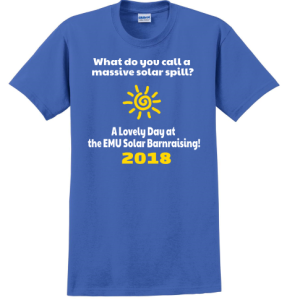
3. Design the Solar Array
An EMU engineering class, led by Professor Esther Tian, helped design the solar array.
Tian’s engineering students met with Johann Zimmermann, a local structural engineer of JZ Engineering who also is involved with EMU’s engineering advisory board. With guidance from Tian and Zimmermann, students studied photovoltaic equipment along with the beams and roofs of the two buildings they were considering. They used that information to create a structural analysis of the solar panel’s impacts and to determine whether the buildings could handle the load of the solar panels.
Zimmermann used this data to give his official engineer’s approval of the solar load on the roofs of the Roselawn and University Commons buildings.
“Of course Johann checked everything first,” Tian reassured me in an interview. But the engineering students’ data held up, and they discovered the roof could hold up the solar panels, too. Tian was excited and proud that her students were “solving real-life problems in the class,” for a project that was over their heads (literally, not figuratively).
“It was truly a student-led project, where students were involved in all stages from beginning to end,” Tian said.
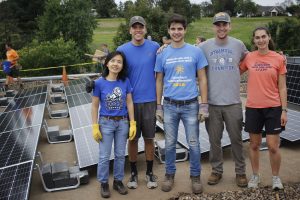
4. Create A Fun and Safe Install Day
The installation process started when the students prepped the roof sites by removing old gravel ballast from the rooftop for several days leading up to the installation.
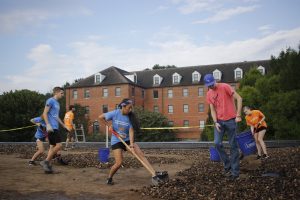
Student involvement didn’t stop there. Students put in the hard work, and were excited to be involved with the solar barn raising.
“It’s the same principle of neighbors or community coming together to build something that would normally take weeks and weeks, and you do it in one day with volunteers,” said Anthony Smith, CEO and president of Secure Futures.
Seventy student volunteers along with solar professionals spent their Saturday from 8 am to 5 pm installing solar panels. This included carrying solar panels and the cement blocks to ballast them to the roof of each building across their campus, hauling them onto a lift, and carrying them across the roofs. Ooof!
But students were all smiles, listening to a music playlist made just for the barn raising.
From beginning to end, this was a modern-day barn raising for the books. The entire EMU community, from the student volunteers to alums of EMU now working for Secure Futures, chipped in to make this project possible.
With this DIY-style solar installation, students were able to see a real-world project from start to finish. This tangible learning experience is something students can take with them into their careers, with the peace of mind that they left their university better than when they first started.
Through this process, we hope other students can try their own DIY solar barn raising with a friendly local solar installer in their area to offer expert guidance. Secure Futures was thrilled to assist a school in our own backyard, and we hope to see other solar installers contribute to their community in a similar fashion.
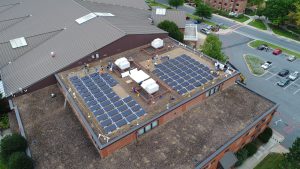
Make This Your Year to Go Solar
Find out what it would take for your college, school, hospital or business to get solar on-site with no upfront capital investment and money savings every month.